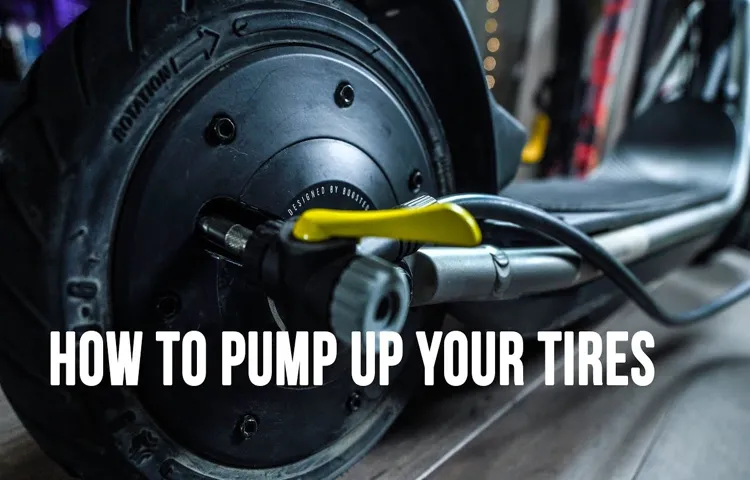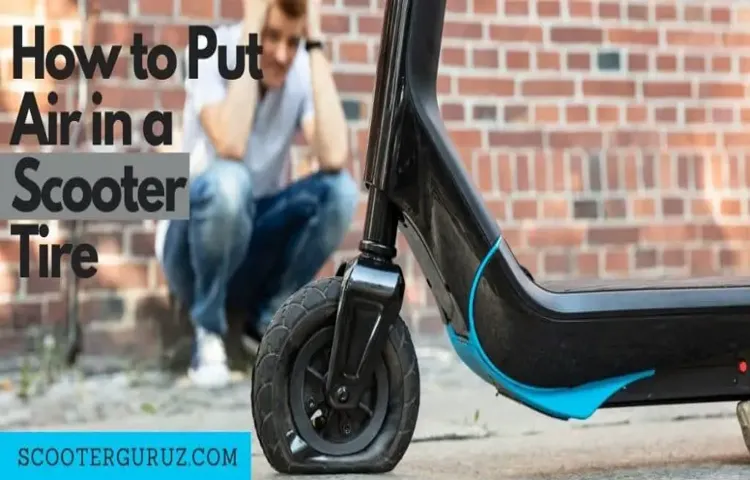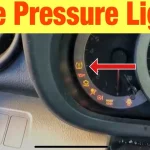Electric scooters have become increasingly popular in recent years thanks to their convenience and eco-friendliness. However, like any other mode of transportation, electric scooters require proper maintenance to ensure smooth and safe riding. One of the essential maintenance tasks for electric scooters is keeping the tires inflated to the correct pressure.
Inflated tires not only provide a more comfortable ride but also prevent damage to the scooter’s rims and prolong the life of the tires. In this blog post, we’ll guide you through the easy steps of how to inflate your electric scooter tire, so you can enjoy a more comfortable and safer ride. Whether you’re a seasoned electric scooter rider or a beginner, this guide will provide valuable insights into maintaining your scooter’s tires and keeping it in good condition.
Table of Contents
Materials Needed
If you’re looking to keep your electric scooter in tip-top shape, learning how to put air in the tires is a crucial skill. To start, you’ll need a few materials on hand: a tire pressure gauge, a bike pump or air compressor (depending on the type of valve your scooter tires have), and of course, your electric scooter. Begin by checking the recommended tire pressure for your scooter (this information should be in your scooter’s manual), and use the tire pressure gauge to ensure that the air pressure in your tires is within the recommended range.
If the pressure is too low, use the bike pump or air compressor to add air, checking the pressure periodically until it reaches the proper level. Be careful not to overinflate the tires, as this can cause them to burst. Once you’re finished, double-check the pressure one last time and you’re good to go! With a little practice, putting air in your electric scooter tires will become second nature.
Electric Scooter
If you’re interested in building your own electric scooter, then you’ll need a handful of materials to get started. First, you’ll need a basic understanding of electronics and access to a soldering kit. You’ll also need a battery, motor, and a controller to regulate the scooter’s speed.
For the frame, you can use a variety of materials such as aluminum tubing, steel, or even wood. Additionally, you’ll need wheels, brakes, and a throttle mechanism to control the scooter’s movements. Depending on your design, you may also need various screws, bolts, and mounting brackets to hold everything together.
Overall, building an electric scooter requires some technical knowledge, but with the right materials and a bit of creativity, you can create a fun and eco-friendly mode of transportation that’s perfect for getting around town.

Pump with a Pressure Gauge
If you want to get the most accurate pressure readings when inflating your sports balls, then using a pump with a pressure gauge is essential. The materials you’ll need include a ball pump with an attached pressure gauge, the ball you want to inflate, and a needle attachment for the pump. Many pumps come with a built-in pressure gauge and needle attachment, but if yours doesn’t, they can easily be purchased separately.
The needle attachment is crucial because it’s what allows the pump to be attached to the inflatable ball’s valve. When putting the needle in the valve, make sure it’s entirely secure as a loose needle will cause air to escape, and the pressure reading won’t be accurate. Once the needle is properly inserted, begin pumping air into the ball, ensuring that you’re monitoring the pressure gauge carefully.
Keep pumping until you reach the recommended pressure, and then remove the needle and close the valve. By using a pump with a pressure gauge, you’ll be able to get the exact pressure level required for optimal performance, keeping your sports balls in top condition for longer.
Valve Adapter
Valve Adapter If you’re looking to convert your valve system, a valve adapter can be just the tool you need. To get started, you’ll need a few materials. First and foremost, you’ll need the valve adapter itself, which you can purchase online or from a hardware store.
The type of valve adapter you need will depend on the system you’re trying to convert, so make sure to do your research beforehand. Additionally, you may need tools such as pliers or a wrench to help you install the adapter. Before you begin, turn off the water supply and drain any remaining water from the system.
Once you have the proper materials and tools, you can begin the installation process. With some basic DIY knowledge and a little bit of patience, you can easily convert your valve system with a valve adapter.
Steps to Inflate Electric Scooter Tire
Inflating an electric scooter tire isn’t as complicated as it may seem. All you need is a tire pump, some basic knowledge, and a little bit of elbow grease. The first thing you’ll want to do is make sure you have the correct tire pressure.
This information can usually be found on the sidewall of the tire or in the user manual. Once you know the correct pressure, remove the valve cap and attach the pump to the valve. Use the pump to slowly inflate the tire until it reaches the recommended pressure.
Be careful not to overinflate the tire, as this can lead to a burst and cause potential damage to the scooter. Once you’ve finished inflating the tire, don’t forget to replace the valve cap and take the scooter for a test ride to ensure everything is in working order. With a little bit of know-how, putting air in your electric scooter tire can be a quick and easy task.
Step 1: Identify the Valve Type
Inflating the tires of your electric scooter is an essential maintenance task that you must perform regularly. However, before you start inflating, you must first identify the valve type of your tire. The two most common valve types are the Schrader valve and the Presta valve, which require different adapters for inflation.
The Schrader valve, also known as an American valve, is the more common type, while the Presta valve, also known as a French valve, is typically found on higher-end scooter models. If you’re not sure which type of valve your tire has, check the manufacturer’s instructions or consult with a professional. Once you’ve identified the valve type, you’re ready to move on to the next steps in inflating your electric scooter tire.
Step 2: Attach Valve Adapter
The second step in inflating an electric scooter tire is to attach the valve adapter to the tire valve. The valve adapter is a small and handy tool designed to fit onto the tire valve and connect to the air compressor hose. Most electric scooters have Presta valves, which require a specific adapter to attach to.
To attach the valve adapter, simply screw it onto the tire valve in a clockwise direction until it clicks into place. Make sure the adapter is sealed tightly to avoid any air leaks during the inflation process. Once the valve adapter is securely attached, the tire is ready for inflation.
Remember to always follow the manufacturer’s recommended tire pressure to ensure optimal performance of your electric scooter. By following these simple steps, you can have your electric scooter ready to ride in no time.
Step 3: Check the Recommended Pressure
When it comes to maintaining your electric scooter, one of the most important steps is checking the recommended tire pressure before inflating the tire. You can usually find this information in the user manual, on the scooter itself, or even online. It’s important to inflate your scooter tire to the recommended pressure because it affects the handling, stability, and overall performance of your scooter.
Underinflated tires can reduce your speed and range, while overinflated tires can make your ride uncomfortable and increase the risk of a blowout. Therefore, it’s best to invest in a tire pressure gauge and make sure to check your tire pressure regularly. By doing so, you’ll not only ensure a smoother ride but also extend the life of your scooter’s tire.
Step 4: Inflate the Tire
Inflating an electric scooter tire may seem like a tedious task, but it is essential for the safety and longevity of your scooter. To start, determine the recommended tire pressure for your electric scooter and locate the valve stem on the tire. Next, attach the pump to the valve stem and begin pumping air into the tire.
Keep an eye on the pressure gauge to ensure you are inflating the tire to the correct pressure. It’s a good idea to check the pressure frequently as you inflate the tire, as over-inflation can cause the tire to burst. Once you’ve reached the recommended pressure, disconnect the pump and check for any leaks.
If there are no leaks, you’re good to go! Remember to check your tire pressure regularly to maintain optimal performance and safety.
Step 5: Check the Pressure
When it comes to inflating the tires of your electric scooter, checking the pressure is an essential step. Once you’ve connected the valve of your tire to the air pump, it’s time to ensure that you’re inflating it to the right pressure level. To find the recommended pressure for your electric scooter tire, refer to the user manual or the label on the tire itself.
Over-inflating or under-inflating the tire can negatively impact the scooter’s performance as well as its safety. Using a pressure gauge is the best way to ensure that you’re inflating the tire to the recommended pressure. A correctly inflated tire can provide a smoother and safer ride for you.
By taking care of your electric scooter’s tires, you can extend their lifespan and avoid potential accidents on the road.
Tips for Maintaining Your Electric Scooter Tire
One of the best things about electric scooters is that they require minimal maintenance. However, regular tire maintenance is important for the longevity of your scooter. It is essential to keep the tire pressure at the recommended level to ensure a smoother and safer ride.
So how to put air in an electric scooter tire? First, you need to locate the valve stem on your tire. Most electric scooters come with a Schrader valve, similar to the one on a car tire. Next, using a pump with the correct nozzle, inflate the tire to the recommended pressure level, usually between 50-70 PSI.
It is important not to overinflate the tire, as this can increase the risk of a blowout. Finally, check the tire pressure regularly to ensure it remains at the recommended level. By following these simple steps, you can ensure a smooth and safe ride on your electric scooter.
Check Tire Pressure Regularly
Maintaining the tire pressure of your electric scooter is crucial to ensure a smooth, safe, and comfortable ride. Checking the tire pressure regularly is one of the most important tips for maintaining your electric scooter tire. Low tire pressure can lead to decreased battery life, reduced speed, and poor handling.
On the other hand, over-inflated tires can cause discomfort, instability, and affect the overall performance of your scooter. You can check the tire pressure using a tire gauge or by taking it to a local mechanic. Remember to set the tire pressure according to the manufacturer’s recommendations, which can be found in the manual or on the tire itself.
So, make sure to keep an eye on your electric scooter tire pressure to optimize its performance and prolong its lifespan.
Avoid Overinflation
When it comes to maintaining your electric scooter tire, proper inflation is crucial. Overinflating your tire can lead to a harsher ride and even damage the tire. Make sure to check the recommended tire pressure in your scooter’s manual and use a reliable pressure gauge to ensure accuracy.
It’s also important to avoid inflating your tire beyond its recommended pressure, as this can increase the risk of a blowout. If you’re unsure about the appropriate tire pressure, don’t hesitate to consult a professional or reach out to the scooter manufacturer for guidance. By following these tips and regularly checking your electric scooter tire pressure, you can ensure a smoother, safer ride.
Store the Scooter Properly
Maintaining your electric scooter tire is essential to ensure a smooth and safe ride. One crucial aspect of tire maintenance is proper storage. When not in use, it’s important to store your scooter in a dry place, away from direct sunlight and extreme temperatures.
It’s also a good idea to keep the tires inflated to the recommended pressure to prevent any flat spots from forming. Additionally, you can invest in a tire cover to protect the tire from dust and moisture buildup. By storing your electric scooter properly, you can prolong the lifespan of your tires and ensure a comfortable and safe ride every time.
Conclusion
And that, my friends, is how you give your electric scooter a breath of fresh air! So next time you feel like your scooter is dragging its feet, remember to check the tire pressure. It’s a quick and easy fix that will keep you zooming along with the wind in your hair. And just think, now you can impress your friends with your newfound knowledge of scooter maintenance.
Who says you can’t teach an old dog new tricks!”
FAQs
Why should I put air in my electric scooter tire?
Putting air in your electric scooter tire is crucial to maintain optimal performance and ensure safety while riding. The right amount of air pressure will ensure better traction, a smoother ride, and prevent punctures.
How do I know when my electric scooter tire needs more air?
You can easily check the air pressure in your electric scooter tire using a tire pressure gauge. If the pressure is lower than the manufacturer’s recommended PSI, it’s time to add some air.
Can I use a regular bike pump to put air in my electric scooter tire?
Yes, you can use a regular bike pump to add air to your electric scooter tire. However, make sure the pump has the correct nozzle to fit the valve stem of your tire.
What is the recommended PSI for electric scooter tires?
The recommended PSI for electric scooter tires varies depending on the make and model. You can find the recommended PSI in the user manual or on the tire itself.
Do I need to replace my electric scooter tire if it keeps losing air?
Not necessarily. If your tire keeps losing air, it could be due to an issue with the valve stem, a puncture, or a damaged rim. You should inspect the tire for any visible damage and repair it if needed.
How often should I check the air pressure in my electric scooter tire?
It’s advisable to check the air pressure in your electric scooter tire every two weeks or before every ride. This will help maintain optimal performance and prevent any unexpected issues while riding.
Can overinflated tires affect the performance of my electric scooter?
Yes, overinflated tires can make your electric scooter feel bumpy and uncomfortable while riding. It can also cause the tires to wear out unevenly, shortening their lifespan. Always ensure you follow the recommended PSI when adding air to your electric scooter tire.



